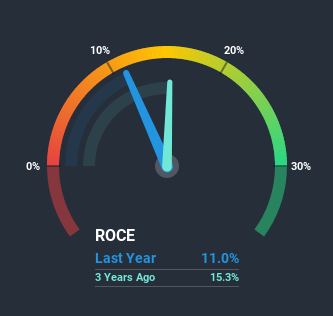
What trends should we look for it we want to identify stocks that can multiply in value over the long term? Firstly, we'll want to see a proven return on capital employed (ROCE) that is increasing, and secondly, an expanding base of capital employed. Put simply, these types of businesses are compounding machines, meaning they are continually reinvesting their earnings at ever-higher rates of return. However, after briefly looking over the numbers, we don't think Axis (GTSM:6292) has the makings of a multi-bagger going forward, but let's have a look at why that may be.
What is Return On Capital Employed (ROCE)?
If you haven't worked with ROCE before, it measures the 'return' (pre-tax profit) a company generates from capital employed in its business. To calculate this metric for Axis, this is the formula:
Return on Capital Employed = Earnings Before Interest and Tax (EBIT) ÷ (Total Assets - Current Liabilities)
0.11 = NT$110m ÷ (NT$1.5b - NT$549m) (Based on the trailing twelve months to September 2020).
So, Axis has an ROCE of 11%. On its own, that's a standard return, however it's much better than the 7.1% generated by the Electrical industry.
Check out our latest analysis for Axis

While the past is not representative of the future, it can be helpful to know how a company has performed historically, which is why we have this chart above. If you're interested in investigating Axis' past further, check out this free graph of past earnings, revenue and cash flow.
What Can We Tell From Axis' ROCE Trend?
There hasn't been much to report for Axis' returns and its level of capital employed because both metrics have been steady for the past five years. Businesses with these traits tend to be mature and steady operations because they're past the growth phase. So unless we see a substantial change at Axis in terms of ROCE and additional investments being made, we wouldn't hold our breath on it being a multi-bagger.
Our Take On Axis' ROCE
In summary, Axis isn't compounding its earnings but is generating stable returns on the same amount of capital employed. Since the stock has gained an impressive 95% over the last five years, investors must think there's better things to come. But if the trajectory of these underlying trends continue, we think the likelihood of it being a multi-bagger from here isn't high.
Since virtually every company faces some risks, it's worth knowing what they are, and we've spotted 3 warning signs for Axis (of which 1 is potentially serious!) that you should know about.
While Axis isn't earning the highest return, check out this free list of companies that are earning high returns on equity with solid balance sheets.
If you decide to trade Axis, use the lowest-cost* platform that is rated #1 Overall by Barron’s, Interactive Brokers. Trade stocks, options, futures, forex, bonds and funds on 135 markets, all from a single integrated account. Promoted
New: Manage All Your Stock Portfolios in One Place
We've created the ultimate portfolio companion for stock investors, and it's free.
• Connect an unlimited number of Portfolios and see your total in one currency
• Be alerted to new Warning Signs or Risks via email or mobile
• Track the Fair Value of your stocks
This article by Simply Wall St is general in nature. It does not constitute a recommendation to buy or sell any stock, and does not take account of your objectives, or your financial situation. We aim to bring you long-term focused analysis driven by fundamental data. Note that our analysis may not factor in the latest price-sensitive company announcements or qualitative material. Simply Wall St has no position in any stocks mentioned.
*Interactive Brokers Rated Lowest Cost Broker by StockBrokers.com Annual Online Review 2020
Have feedback on this article? Concerned about the content? Get in touch with us directly. Alternatively, email editorial-team@simplywallst.com.
About TPEX:6292
Axis
Engages in the manufacture, process, trade, and import and export of appliances and related peripheral parts in Taiwan.
Flawless balance sheet slight.
Similar Companies
Market Insights
Community Narratives





